Hamburg is a major city in Germany and is home to many different species of birds. In the city, you can find a wide variety of birds, from the common sparrows to rare species such as the Eurasian hobby.
Hamburg also offers ideal habitats for migratory birds, with wetlands and reed beds making up a large part of the city’s green spaces. Hamburg is also home to a variety of bird sanctuaries, where birds can find shelter and nesting sites.
With its diverse habitats, Hamburg is a great place to observe and learn about birds.
1. Mallard
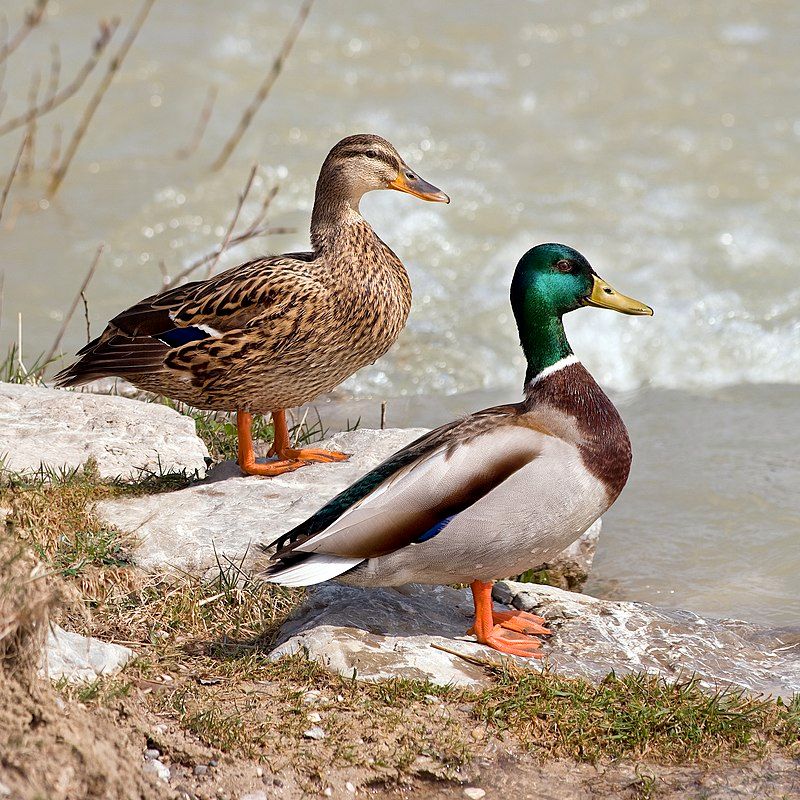
The mallard or wild duck is a species of duck that inhabits many regions around the world. It is native to the temperate and subtropical regions of the Americas, Eurasia, and North Africa.
In recent years, it has been introduced to a number of other areas beyond its native range. New Zealand, Australia, Peru, Brazil, Uruguay, Argentina, Chile, Colombia, the Falkland Islands, and South Africa are all areas where the mallard has been introduced.
The mallard is a dabbling duck, meaning it feeds by tipping its head underwater and upending its body, allowing it to use its bill to filter food from the water. Its diet consists of aquatic plants and small aquatic animals, such as insects, crustaceans, and worms.
It is also an opportunistic feeder, meaning it will feed on a variety of food sources, including agricultural crops. The mallard is a highly social species and gathers in large flocks during the breeding season.
The male is known for its distinctive iridescent green head and white ring around its neck. The female is a gray-brown color and is generally less conspicuous than the male. The mallard is also known for its hardy nature and ability to adapt to a wide range of habitats.
The mallard is an important species in the global ecosystem. Its presence helps to maintain the health of wetlands and other aquatic habitats, and its population is an important food source for many predators.
As a result, it is important to protect and conserve this species and its habitats.
| Kingdom | Animalia |
| Phylum | Chordata |
| Class | Aves |
| Order | Anseriformes |
| Family | Anatidae |
| Genus | Anas |
| Species | A. platyrhynchos |
2. Egyptian Goose
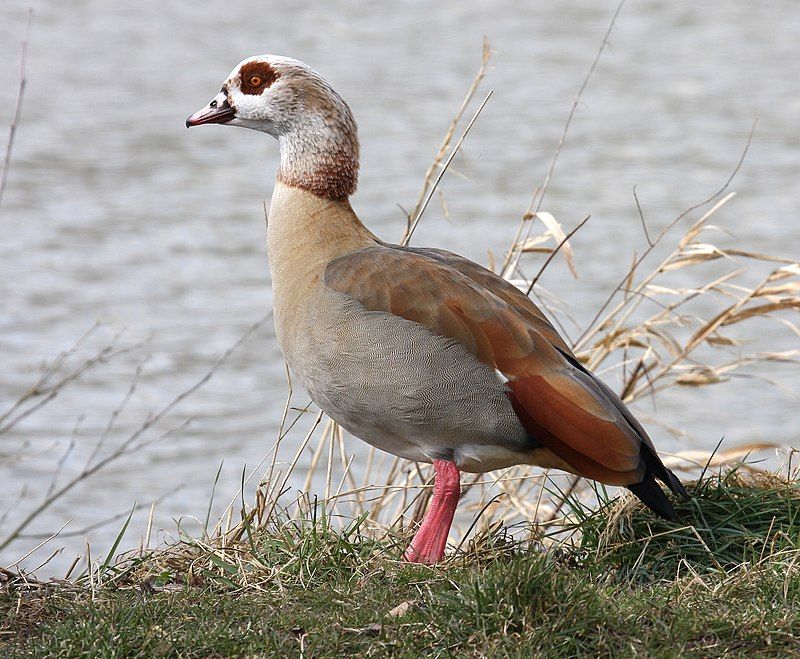
The Egyptian goose is a species of duck that is native to Africa and is part of the Anatidae family. It is a popular bird, especially as an ornamental species, and as such, has been introduced to many parts of the world that are outside of its native range.
This includes Europe, the United States, and other countries. The Egyptian goose gets its name from its native range in Egypt. It is a medium-sized bird, typically measuring around 75 cm in length and weighing up to 2 kg.
They are easily recognizable due to their distinctive reddish-brown feathers, white underparts, and black and white head. They have a long, slender neck and a black tail. The Egyptian goose is a gregarious species that prefers to live in pairs or small groups.
They feed mainly on plants, seeds, insects, and small aquatic creatures.
They tend to nest in reed beds and ponds, and their chicks are able to swim shortly after hatching. The Egyptian goose is a popular ornamental bird due to its attractive feathers and its ability to adapt to captivity.
It is a popular choice for waterfowl collections and aviaries and is also used in falconry. It is important to note that in some areas, the introduction of this species has caused problems for local ecosystems.
It is important to be aware of this before introducing the species to new areas.
| Kingdom | Animalia |
| Phylum | Chordata |
| Class | Aves |
| Order | Anseriformes |
| Family | Anatidae |
| Genus | Alopochen |
| Species | A. aegyptiaca |
3. Great Crested Grebe
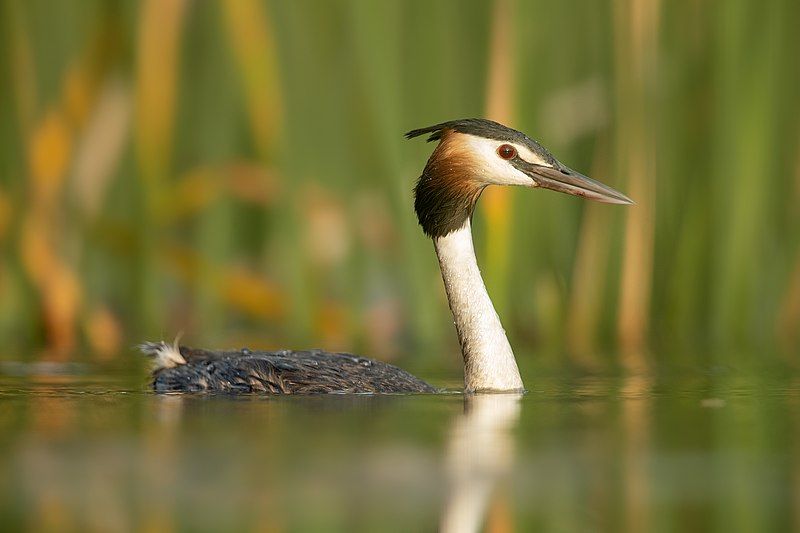
The great crested grebe is a species of bird that belongs to the grebe family. It is found in freshwater and coastal wetlands across much of Europe, Asia, and North America. This species of bird is known for its distinctive courtship display, which is quite elaborate and unique.
It begins with the male and female performing a water dance, wherein they move their feet in an intricate manner. They then perform a complex series of behaviors, including swimming in a circle, bobbing up and down, and head-shaking.
The two birds then dive under the water and emerge with a fish clasped in their bill, which they share to show their commitment to each other. This ritual is repeated several times, with the male and female exchanging gifts of twigs and feathers.
This elaborate display is known to last for up to an hour and is a beautiful sight to behold.
| Kingdom | Animalia |
| Phylum | Chordata |
| Class | Aves |
| Order | Podicipediformes |
| Family | Podicipedidae |
| Genus | Podiceps |
| Species | P. cristatus |
4. Greylag Goose
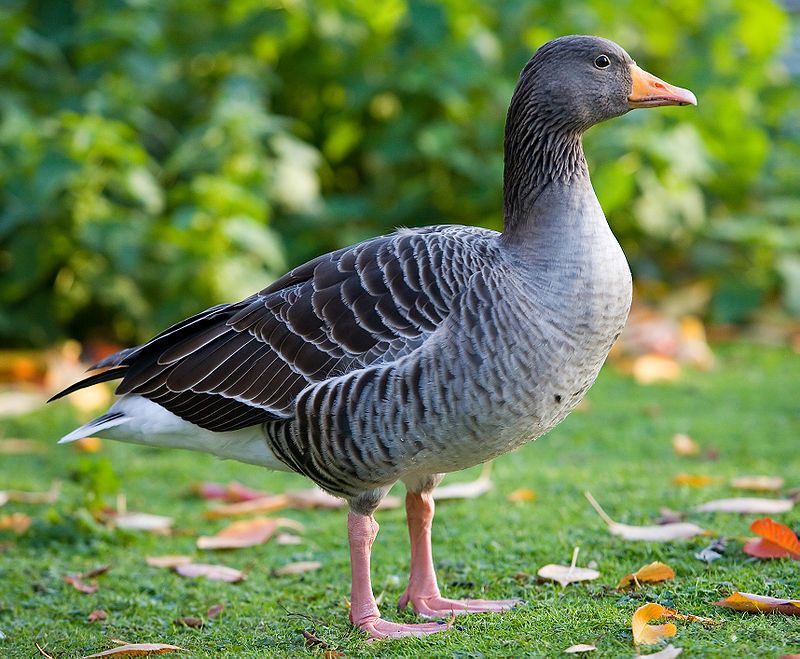
The Greylag goose is a species of large waterfowl that belongs to the family Anatidae. It is the type species of the genus Anser. This species of goose has a unique plumage pattern which consists of mottled and barred grey and white feathers.
Additionally, it has an orange beak and pink legs which are prominent features of the Greylag goose.
Its size is slightly larger than the average goose, making it a distinct species in the family Anatidae. The Greylag goose is found in open wetlands, grassy fields, and near coasts. It is an omnivore, feasting on insects, plants, small rodents, and other small animals.
It is an important species for the ecosystem, as it helps to control insect and rodent populations. Additionally, it is a popular species for hunters. The Greylag goose is also an important species for ornithology.
It is one of the first species to be studied by scientists, and its behavior and ecology is well known.
It is an important species for conservation efforts, and it is listed as a species of least concern on the IUCN Red List. Overall, the Greylag goose is an important species for the environment and for science.
Its mottled and barred plumage, orange beak, and pink legs make it a distinct species in the family Anatidae, and its size and behavior make it an important species in its ecosystem.
| Kingdom | Animalia |
| Phylum | Chordata |
| Class | Aves |
| Order | Anseriformes |
| Family | Anatidae |
| Genus | Anser |
| Species | A. anser |
5. Ruddy Shelduck
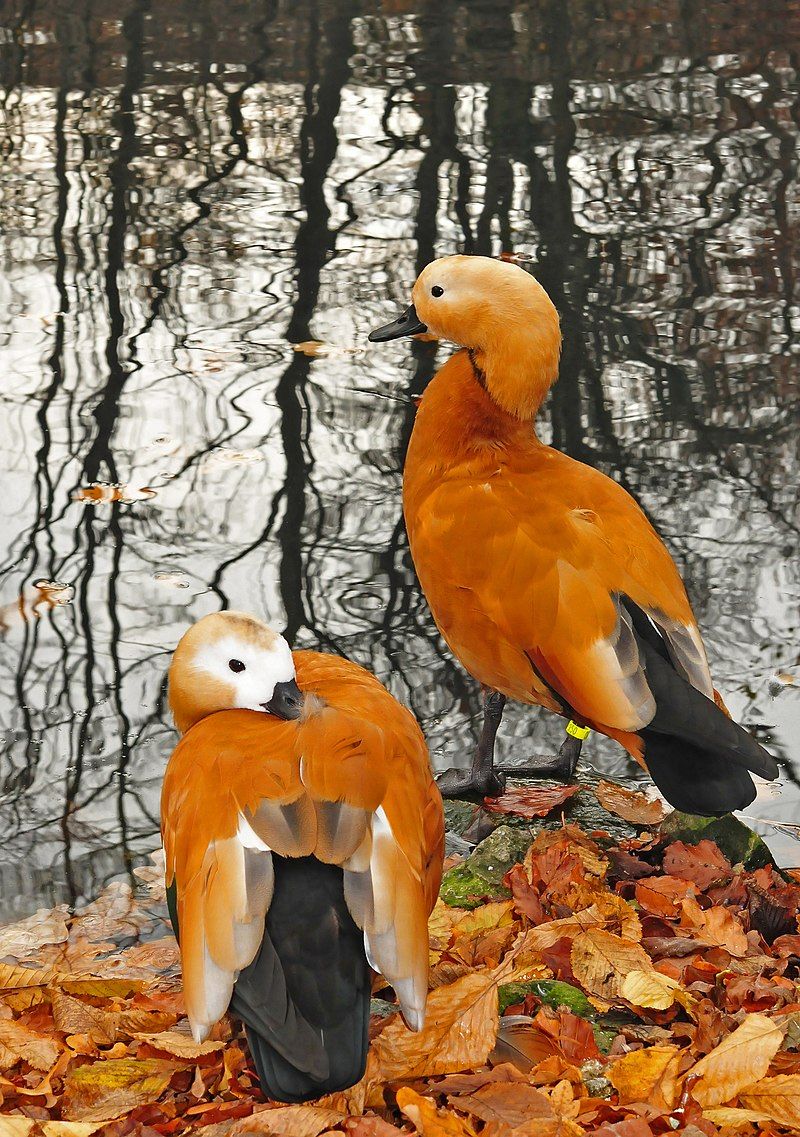
The ruddy shelduck, commonly referred to as the Brahminy duck in India, is a species of waterfowl from the Anatidae family. It is a colorful bird, typically measuring 58 to 70 centimeters in length and having a wingspan of 110 to 135 centimeters.
It is easily recognized by its unique coloration, which is reddish-brown on its upperparts, and white on its lowerparts. Its head is black, with a white patch on its face and a light gray-blue beak. Its legs and feet are bright orange.
This species inhabits wetlands, marshes, rivers, and lakes across much of its range in the Indian Subcontinent, parts of Europe, and parts of Africa. They are usually seen in pairs or small groups and are known to feed on aquatic vegetation, insects, and crustaceans.
| Kingdom | Animalia |
| Phylum | Chordata |
| Class | Aves |
| Order | Anseriformes |
| Family | Anatidae |
| Genus | Tadorna |
| Species | T. ferruginea |
6. Little Grebe
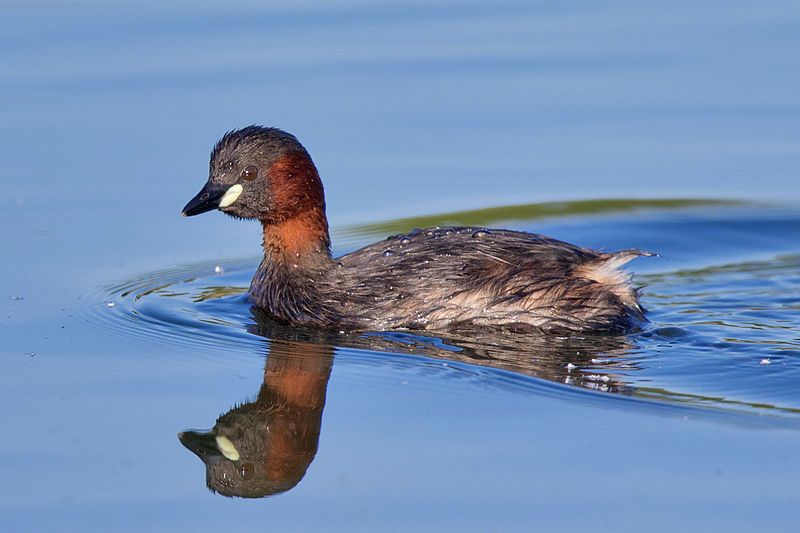
The little grebe, commonly referred to as the dabchick, is a small water bird belonging to the grebe family. The genus of this species is derived from two Ancient Greek words – takhus, which roughly translates to “fast”, and bapto, which means “to sink under”.
The specific ruficollis comes from two Latin words – Rufus, meaning “red”, and Collis, which roughly translates to “necked” and is derived from the Latin word for “neck”. This species is thus aptly named due to its red neck feathers.
| Kingdom | Animalia |
| Phylum | Chordata |
| Class | Aves |
| Order | Podicipediformes |
| Family | Podicipedidae |
| Genus | Tachybaptus |
| Species | T. ruficollis |
7. Lesser White-fronted Goose
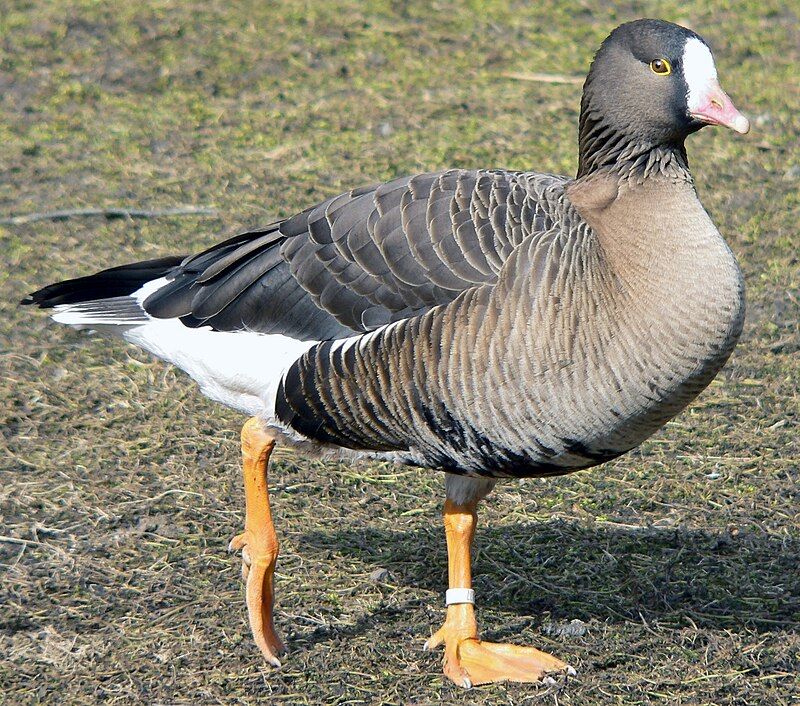
The lesser white-fronted goose is a species of goose that is closely related to the larger white-fronted goose. It is found primarily in the northern part of the Palearctic region, which includes Europe, Asia, and North Africa.
In Europe, the lesser white-fronted goose is a scarce breeder, meaning that there are very few of the species in the area. In an effort to increase the population of the species, a reintroduction program has been proposed in Fennoscandia, a region in northern Europe.
This program would help to boost the numbers of the species in Europe and ensure its survival in the area. In addition to reintroduction programs, conservation efforts are also being taken to protect this species and its habitats.
These efforts include protecting its breeding grounds and preserving its migration routes. By taking these steps, the lesser white-fronted goose can be preserved and its population can remain stable in the future.
| Kingdom | Animalia |
| Phylum | Chordata |
| Class | Aves |
| Order | Anseriformes |
| Family | Anatidae |
| Genus | Anser |
| Species | A. erythropus |
8. Red-necked Grebe
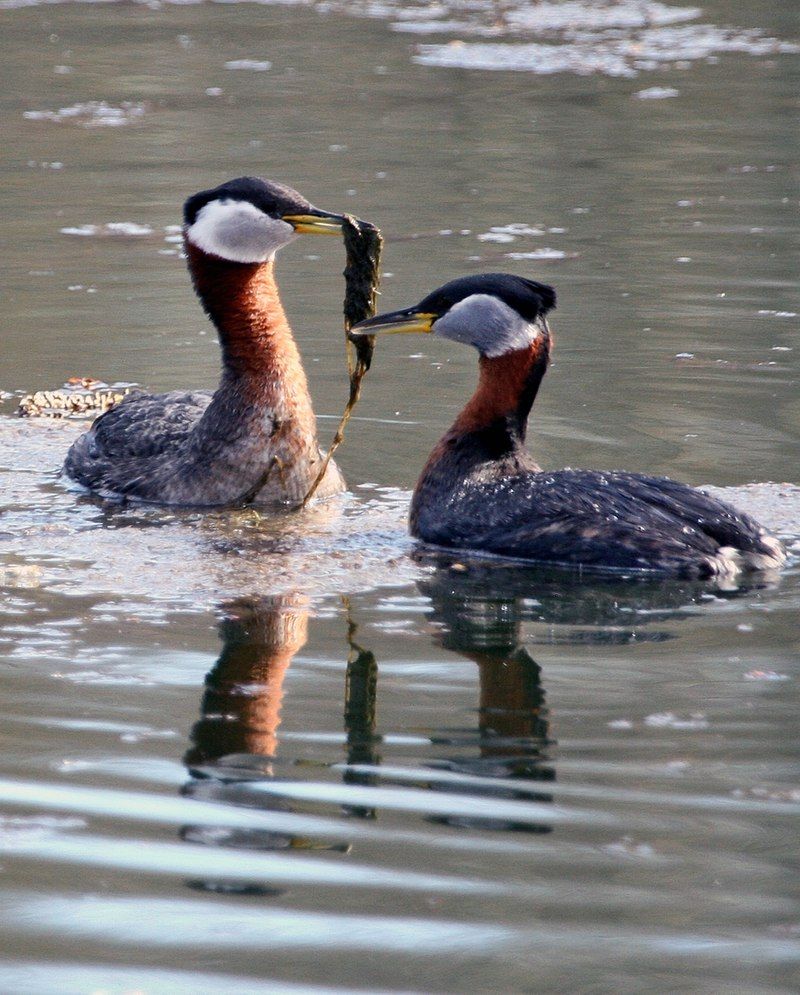
The red-necked grebe is a migratory aquatic bird found in temperate regions of the northern hemisphere. Its breeding habitat is typically inland lakes, but it migrates to the coasts during the winter months.
It prefers to inhabit calm waters beyond the waves of the ocean coasts, although some birds may choose to stay in large lakes instead.
The red-necked grebe is a medium-sized bird that has unique red or yellow-brown markings on its neck and upper breast, which is how it got its name. It usually feeds on fish, insects, and crustaceans.
This bird is an important indicator species of wetland health and is important to the ecosystems they inhabit.
| Kingdom | Animalia |
| Phylum | Chordata |
| Class | Aves |
| Order | Podicipediformes |
| Family | Podicipedidae |
| Genus | Podiceps |
| Species | P. grisegena |
9. Whooper Swan
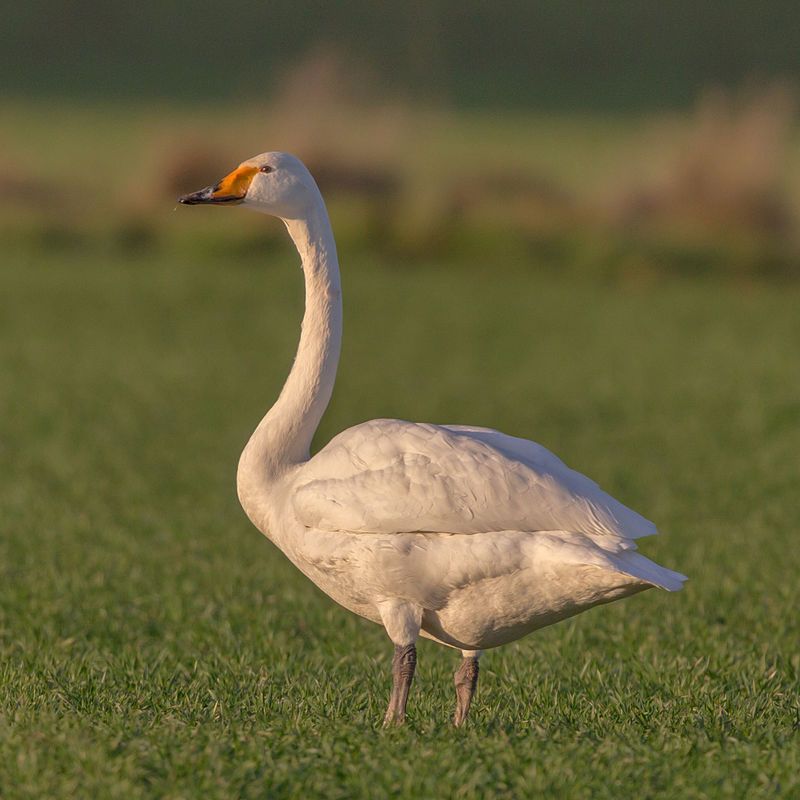
The Whooper Swan, also known as the Common Swan, is a large swan native to the northern hemisphere. It is the Eurasian counterpart of the North American Trumpeter Swan and is the type species for the genus Cygnus.
Whooper Swans have white plumage with an orange beak and black legs. Their wingspan can reach up to 2.5 meters, making them one of the largest flying birds in the world.
They feed mainly on aquatic plants and small fish and can be found in wetlands, lakes, rivers, and coastal areas throughout their range.
Whooper Swans are social birds and can often be seen in large flocks, though they are relatively peaceful and are not known to be aggressive to humans.
They are migratory birds, and their wintering grounds vary depending on the population, but they can often be seen in northern Europe, northern China, and Japan.
Whooper Swans are currently listed as of least concern on the IUCN Red List, though their populations are decreasing due to habitat loss and illegal hunting.
| Kingdom | Animalia |
| Phylum | Chordata |
| Class | Aves |
| Order | Anseriformes |
| Family | Anatidae |
| Genus | Cygnus |
| Species | C. cygnus |
10. Black Stork
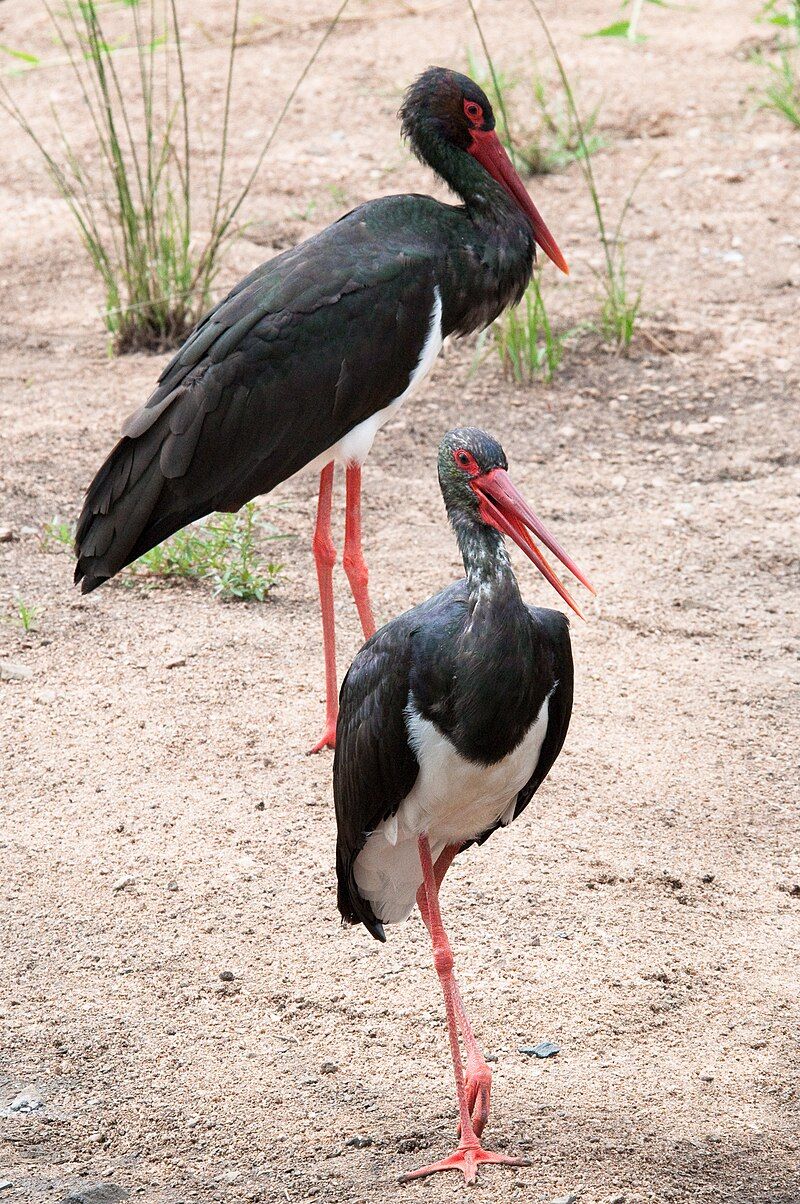
The black stork is a species of large bird that belongs to the Ciconiidae family. This family of birds is composed of wading birds that are typically found in tropical and temperate regions.
The black stork was first described by Carl Linnaeus in the 10th edition of his Systema Naturae, which is a highly influential work in the field of natural history. The black stork is a large bird, with males reaching a height of around 95 cm and a weight of around 1.5 kg.
It has a black head, neck, and wings, and its back is greyish-brown. Its legs are red and its bill is black. It is a predominantly solitary species, but it forms small flocks during winter when it migrates.
Its diet largely consists of aquatic creatures such as fish, frogs, and crustaceans, which it catches in shallow water. It also eats small rodents, insects, and even carrion.
The black stork is found in wetlands, lakes, marshes, and rivers throughout Europe, northern Africa, and parts of Asia.
It is listed as the least concern species by the International Union for Conservation of Nature, but its population is decreasing due to a range of threats, including habitat loss and human disturbance.
| Kingdom | Animalia |
| Phylum | Chordata |
| Class | Aves |
| Order | Ciconiiformes |
| Family | Ciconiidae |
| Genus | Ciconia |
| Species | C. nigra |
11. Gadwall
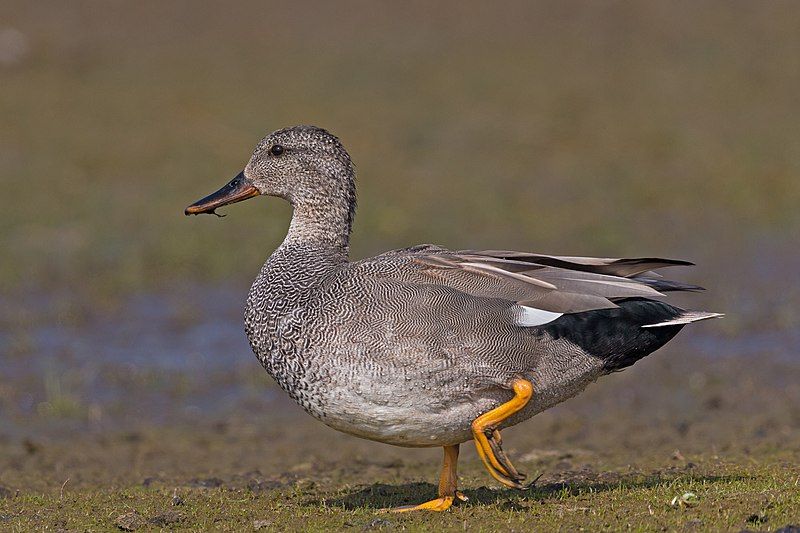
The gadwall is a species of dabbling duck that belongs to the Anatidae family. It is a large duck, with males measuring up to 21 inches long and weighing up to 3.6 pounds. The gadwall has a grayish-brown plumage with a white belly and a black tail with white edges.
It also has a white line at the base of its bill and a yellowish-orange patch at the base of its bill.
The gadwall is found all over North America, from Alaska to Mexico, and is considered to be the most common and widespread duck in the Anatidae family. The gadwall is an adaptable species and can be found in a variety of habitats, from wetlands and wooded areas to agricultural areas and even city parks.
It is an omnivore and will feed on a variety of plant matter, as well as insects, mollusks, crustaceans, fish, and even small mammals.
During the breeding season, the gadwall will form pairs, and the female will build a nest in a shallow depression on the ground, lined with down and grasses. The female will then lay 8 to 12 eggs, which she will incubate for up to 28 days.
The young ducklings will then fledge at 4 to 6 weeks of age. The gadwall is an important species to North American ecosystems and is a popular game bird for hunters.
It is also an important component of the waterfowl population, and its conservation is important for the health of wetlands and other water bodies.
| Kingdom | Animalia |
| Phylum | Chordata |
| Class | Aves |
| Order | Anseriformes |
| Family | Anatidae |
| Genus | Mareca |
| Species | M. strepera |
12. Northern Shoveler
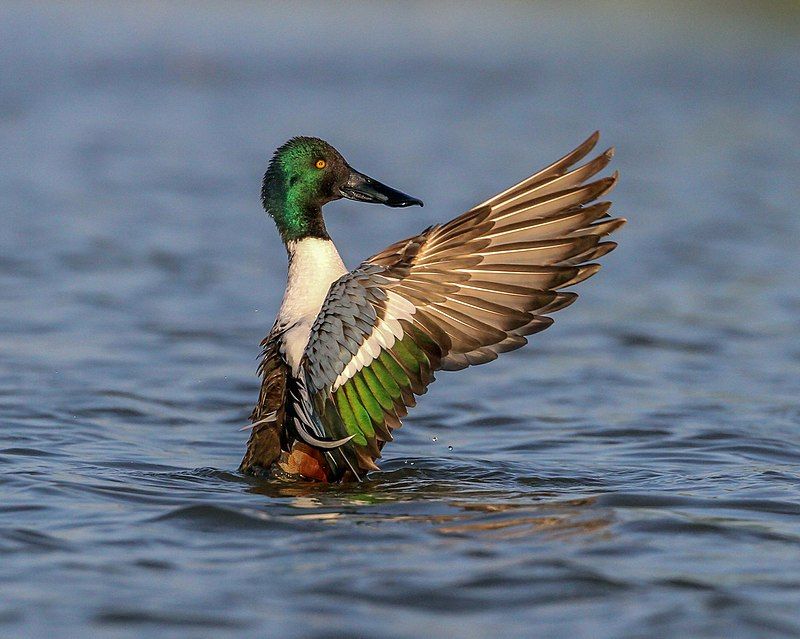
The northern shoveler is a species of duck that is found widely across the world. It is known as the shoveler in Britain, and it is a common duck species. This duck breeds in northern parts of Europe, as well as across the Palearctic region, and across North America.
During the winter season, these ducks migrate to southern Europe, the Indian subcontinent, Southeast Asia, Central America, the Caribbean, and northern South America.
This wide distribution of the northern shoveler, combined with its common status, makes it one of the most widespread ducks in the world.
| Kingdom | Animalia |
| Phylum | Chordata |
| Class | Aves |
| Order | Anseriformes |
| Family | Anatidae |
| Genus | Spatula |
| Species | S. clypeata |
13. Tundra Swan
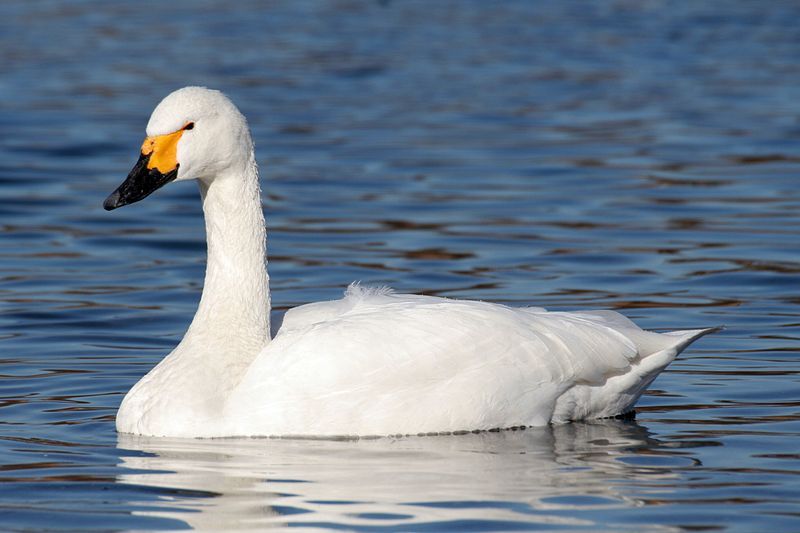
The Tundra Swan is a species of swan found in the Holarctic region, which includes the Palaearctic and Nearctic regions. It is a small species, with two taxonomic classifications.
Generally, these two taxonomic classifications are seen as the same species, but there are some cases where they are regarded as separate species.
The first of these is Bewick’s Swan, which is found in the Palaearctic region, and the second is the Whistling Swan, which is found in the Nearctic region. The Whistling Swan is the largest of the two, with adults growing to a length of around 125 cm.
It has a black bill, and its plumage is generally white with a greyish-black patch on its back. This species can be found in a variety of habitats, from wetlands to tundra and grasslands.
It is an opportunistic feeder, eating a wide variety of aquatic vegetation and small animals such as insects and crustaceans. Bewick’s Swan is slightly smaller than the Whistling Swan, growing to a length of around 110 cm.
It has a yellow bill, and its plumage is generally white with a greyish-black patch on its back. This species is found mainly in the Palaearctic region, where it inhabits wetlands and open grasslands.
It feeds mainly on aquatic vegetation, such as grasses and sedges, and occasionally on small animals such as insects. Both species of the Tundra Swan are classified as near threatened, and they are protected by international law.
Despite this, their numbers are still declining in many areas due to habitat loss and hunting. Therefore, it is important to take measures to ensure that these species are not lost in the wild.
| Kingdom | Animalia |
| Phylum | Chordata |
| Class | Aves |
| Order | Anseriformes |
| Family | Anatidae |
| Genus | Cygnus |
| Species | C. columbianus |
14. Brant
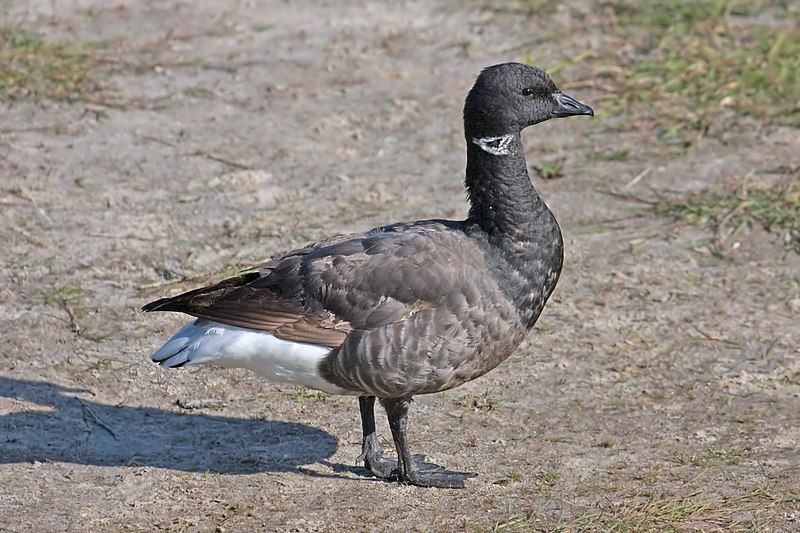
The brant or Brent goose is a species of waterfowl belonging to the genus Branta. It is a small goose with three distinct subspecies, which are found in temperate coastal areas during the winter season and on the high-Arctic tundra during the breeding season.
This species has been an important source of food for coastal communities around the world for centuries. The Brent oilfield is a major oilfield located in the North Sea, off the coast of Scotland.
It was named after this species, as the oilfield was discovered in the same region where the Brent goose can be commonly found. This oilfield is responsible for a significant portion of the United Kingdom’s oil production and is one of the largest oilfields in the world.
| Kingdom | Animalia |
| Phylum | Chordata |
| Class | Aves |
| Order | Anseriformes |
| Family | Anatidae |
| Genus | Branta |
| Species | B. bernicla |
15. Water Rail
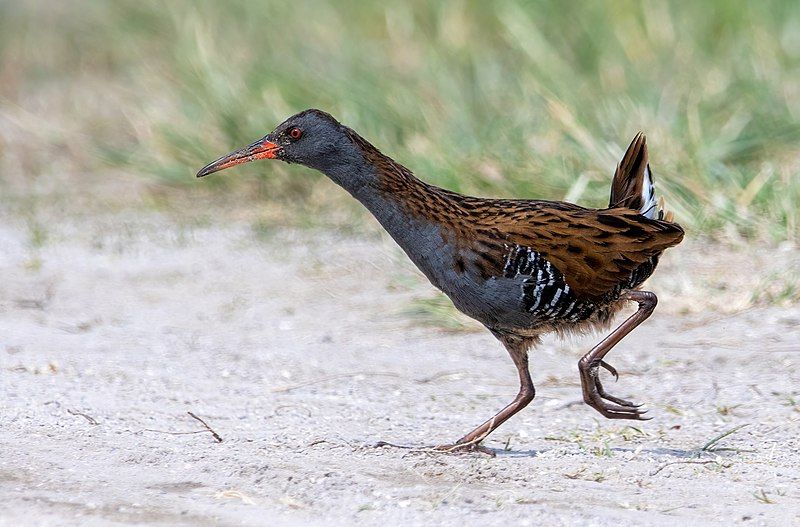
The water rail is a species of bird that belongs to the rail family. It is found in wetlands across Europe, Asia, and North Africa. These wetlands are usually well-vegetated, providing the water rail with plenty of food and shelter.
Some populations in northern and eastern regions are migratory, meaning they move to different areas for breeding and feeding. However, in the warmer parts of its range, the water rail remains a permanent resident, not needing to make any long-distance journeys.
| Kingdom | Animalia |
| Phylum | Chordata |
| Class | Aves |
| Order | Gruiformes |
| Family | Rallidae |
| Genus | Rallus |
| Species | R. aquaticus |
16. Great Cormorant
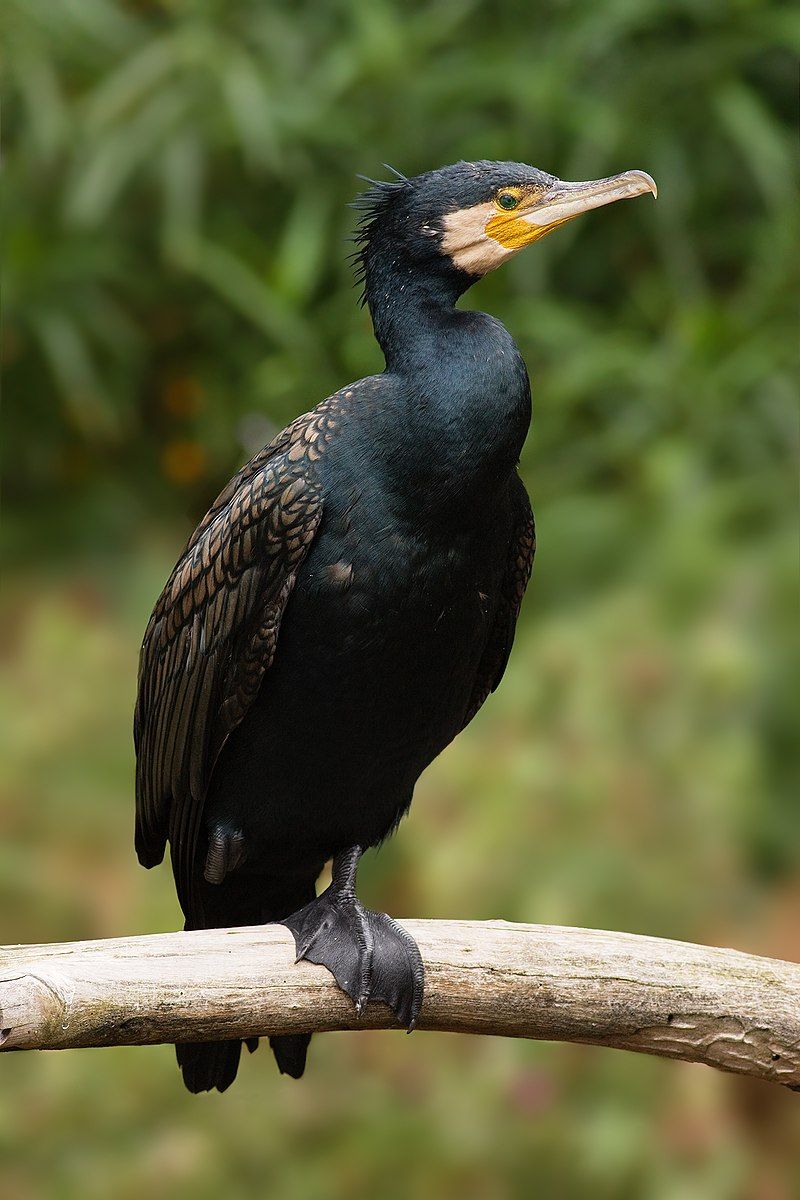
The great cormorant is a type of seabird that can be found across the Northern Hemisphere, Australia, New Zealand, and India.
It is sometimes referred to as the black shag or kawau in New Zealand, the great black cormorant in the Northern Hemisphere, the black cormorant in Australia, and the large cormorant in India.
It is a member of the cormorant family and is widely distributed across these regions. The great cormorant is a large bird, with an average wingspan of 76 to 90 cm. It has dark feathers, which can range in color from black to a glossy greenish black.
The bird also has a yellowish-orange throat and bill, and its eyes are bright yellow. It is a powerful flier and is often seen soaring high in the sky.
The great cormorant is a highly adaptable bird and can be found in a variety of habitats, including coasts, rivers, lakes, and estuaries. They feed on fish, crabs, and other aquatic creatures, and will often dive deep into the water in search of food.
They have large pouch-like throat sacs, which they use to store their prey. The great cormorant is a social bird, often seen in large flocks. It is also a long-lived species and can reach up to 20 years in the wild.
They are an important part of the ecosystem, helping to keep the aquatic environment healthy by controlling the population of certain fish species. Overall, the great cormorant is a fascinating species that can be found in a variety of places around the world.
It is an important part of the ecosystem and is a source of food for many people, who rely on them for sustenance.
| Kingdom | Animalia |
| Phylum | Chordata |
| Class | Aves |
| Order | Suliformes |
| Family | Phalacrocoracidae |
| Genus | Phalacrocorax |
| Species | P. carbo |
17. Spotted Crake
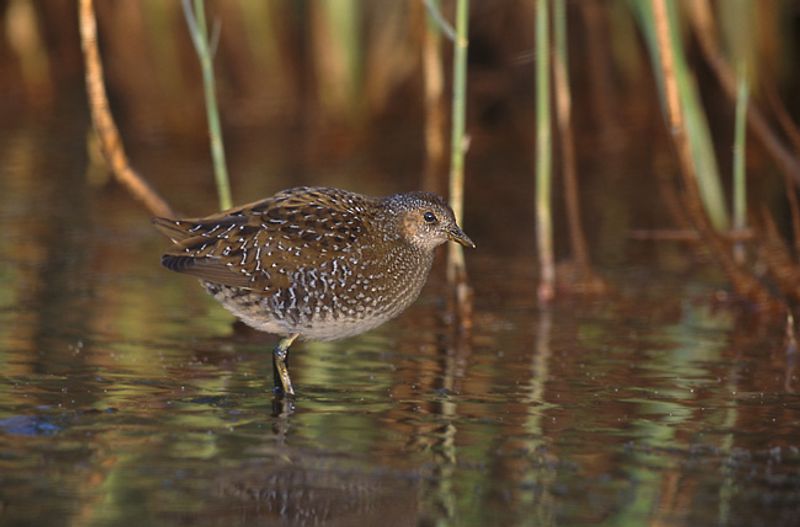
The spotted crake is a small waterbird belonging to the family Rallidae. It is distinguished by its scientific name which is derived from Venetian terms for small rails.
The spotted crake typically inhabits temperate areas of Europe and western Asia, with its breeding habitat typically including marshes and sedge beds. During the breeding season, the spotted crake nests in a dry area among marsh vegetation, laying between 6 and 15 eggs.
The spotted crake is a shy bird and is generally observed to be secretive in behavior, which can make it difficult to spot in the wild. As such, the spotted crake is considered to be an uncommon species in most areas.
| Kingdom | Animalia |
| Phylum | Chordata |
| Class | Aves |
| Order | Gruiformes |
| Family | Rallidae |
| Genus | Porzana |
| Species | P. porzana |
18. Stock Dove
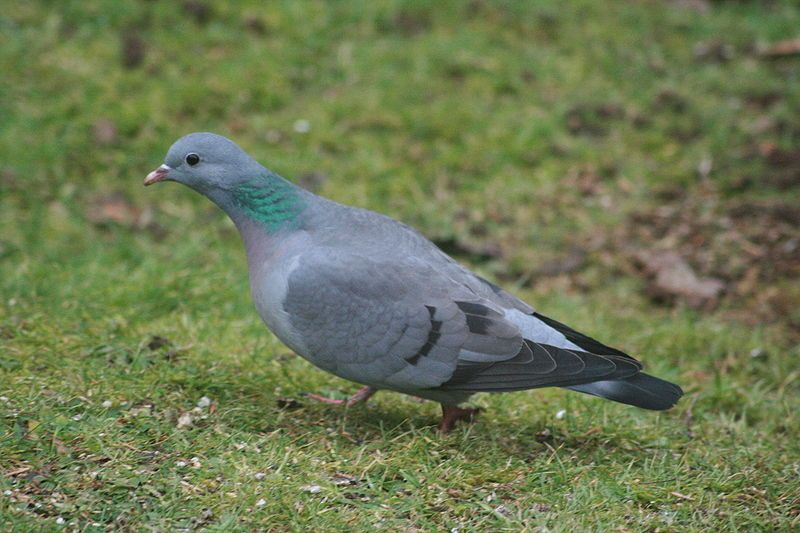
The Stock Dove, or Stock Pigeon, is a species of bird in the family Columbidae, which includes doves and pigeons. It is widespread in the western Palearctic region, which covers most of Europe and North Africa.
The Stock Dove is a medium-sized bird, with a length of 29-34 cm and a wingspan of 54-64 cm. It is mainly grey in color, with a white rump and a grey head.
Its plumage is slightly darker than most other doves and pigeons, and it has a distinctive black and white striped patch on its wings. The Stock Dove prefers open woodlands, farmland, and cultivated gardens.
It feeds mainly on grains and seeds, and it can also be seen eating small invertebrates. The Stock Dove is a gregarious bird, often seen in flocks. During the breeding season, it is monogamous and builds its nest in a tree or bush.
The Stock Dove is a common and widespread species, and it faces no major threats.
| Kingdom | Animalia |
| Phylum | Chordata |
| Class | Aves |
| Order | Columbiformes |
| Family | Columbidae |
| Genus | Columba |
| Species | C. oenas |
19. Mute Swan
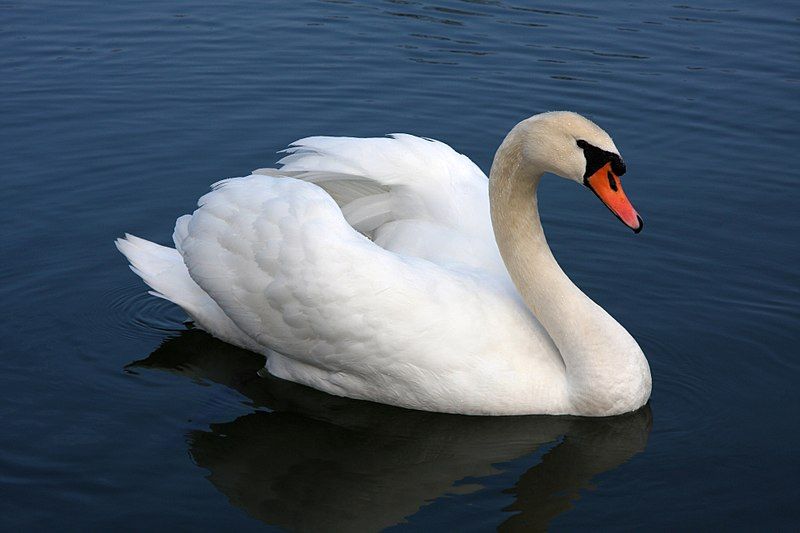
The mute swan is a species of swan belonging to the family Anatidae, which is a group of large waterfowl that also includes ducks and geese.
It is native to a large area of Eurasia and North Africa, spanning from the United Kingdom and Ireland in the west to Siberia in the east, and from Scandinavia in the north to the Nile Valley and Turkey in the south.
The mute swan is the most widespread species of swan in the world, and it can be found in a variety of habitats, such as freshwater lakes, rivers, marshes, and estuaries. The mute swan is a large bird, with a wingspan that can reach up to 1.4 to 2.3 meters.
It is primarily white in color, with an orange beak and black legs and feet. The species is known for its distinctive, loud honking call.
The mute swan is often seen swimming slowly in pairs or small groups, and it prefers to feed on aquatic plants, such as water lilies, as well as insects, worms, and small mollusks.
It is also an important species for many fish species, as its droppings provide important nutrients for the food chain. The mute swan is a highly territorial bird, and it will often chase away any other species that encroach on its territory.
It is a monogamous species, and it will usually form a bond with its mate for life. The female will usually lay a clutch of three to seven eggs, and the young will typically fledge after about seven weeks.
The mute swan is classified as a species of least concern by the International Union for Conservation of Nature, as its population is relatively stable and widespread.
| Kingdom | Animalia |
| Phylum | Chordata |
| Class | Aves |
| Order | Anseriformes |
| Family | Anatidae |
| Genus | Cygnus |
| Species | C. olor |
20. Eurasian Wigeon
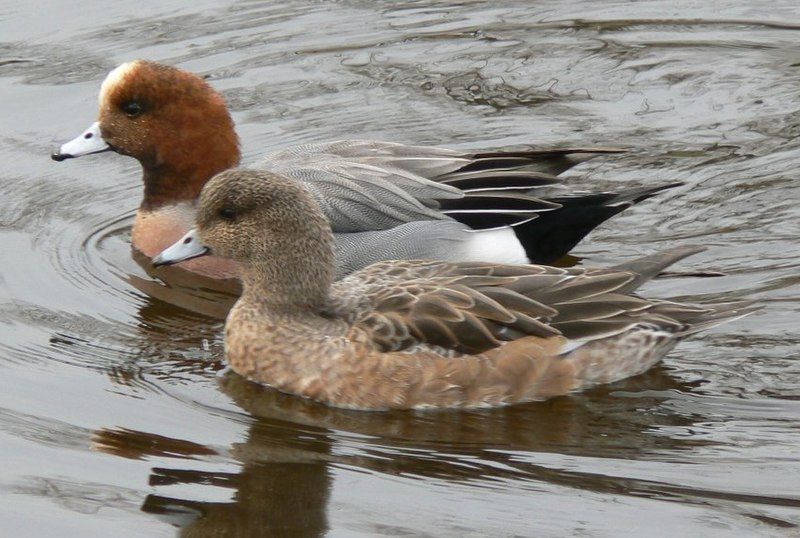
The Eurasian wigeon, also known as the European wigeon, widgeon, or simply the wigeon, is a species of dabbling ducks within the genus Mareca.
This species is widely distributed throughout its Palearctic range, making it one of the most abundant and widespread ducks in the world. It has a wide variety of habitats, from ponds and lakes to marshes and wetlands, making it an adaptable species.
Its diet consists mainly of aquatic plants, seeds, and insects, and it is a social species that forms flocks during the winter months. The Eurasian wigeon is easily identifiable by its distinct white patch on its forehead and its bright orange-brown chest.
In addition, its bright white wings, barred with black, are easily seen in flight. Overall, the Eurasian wigeon is a common and widespread duck species in its native Palearctic range, and its adaptability and resilience make it a valuable part of the ecosystem.
| Kingdom | Animalia |
| Phylum | Chordata |
| Class | Aves |
| Order | Anseriformes |
| Family | Anatidae |
| Genus | Mareca |
| Species | M. penelope |
Conclusion
Hamburg is home to a wide variety of bird species, from the common sparrows to the rare and threatened species.
Hamburg has many birdwatching opportunities for people of all ages, whether they are interested in the local birds or the more exotic species that pass through the city. Bird watching is a great way to connect with nature and appreciate the beauty and diversity of birds.
With the right knowledge and equipment, anyone can become a successful birdwatcher in Hamburg.